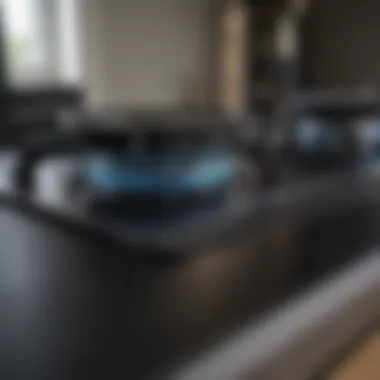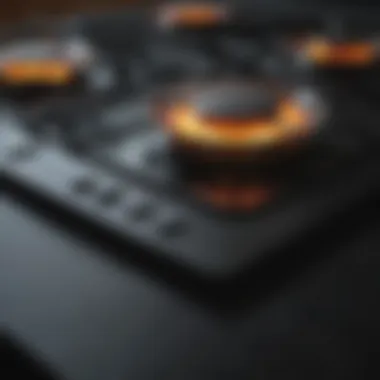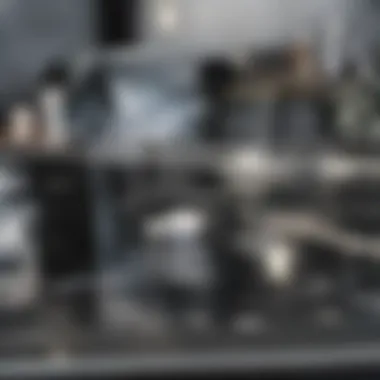Comprehensive Guide to Cleaning Black Glass Stove Tops


Intro
A black glass stove top offers a modern touch to any kitchen, while also presenting specific cleaning challenges. Many homeowners appreciate the sleek appearance these surfaces provide. However, maintaining a clean black glass stove top requires specific knowledge of techniques and products that will not cause damage. This guide explores essential methods that not only keep your stove top spotless but also ensure its longevity.
Proper maintenance is vital in preserving not just the beauty, but also the functionality of your appliance. The right cleaning materials and techniques can make a noticeable difference in appearance as well as performance.
Let’s begin by discussing several important considerations that will help you navigate the nuances of preserving your black glass stove top.
Importance of Regular Maintenance
Regular cleaning prevents residue buildup that can affect cooking efficiency. Over time, food spills and splatters can become stubborn stains. If left untreated, these stains can become increasingly difficult to remove and may even damage the surface. Developing a routine maintenance schedule is beneficial.
Preventing Damage
Black glass is susceptible to scratching and discoloration. Using improper cleaning tools or techniques can lead to irreversible damage. Therefore, one must be cautious in selecting items for cleaning.
"A regular cleaning schedule can minimize the need for tough scrubbing, reducing the risk of scratches on your black glass stove top."
Recommended Cleaning Supplies
Selecting appropriate cleaning products can be a key factor for effective maintenance. Below is a list of recommended items:
- Soft microfiber cloths: Useful for wiping down surfaces without scratching.
- Glass cleaner: Ensure it is ammonia-free to avoid harm to the surface.
- Non-abrasive sponge: For stubborn stains without scratching the surface.
- Baking soda: This common household item serves as a gentle abrasive cleaner.
Using these products will help maintain the aesthetic appeal of your stove top while avoiding damaging effects from harsher chemicals.
Cleaning Techniques
The method you choose to clean your stove top can determine its longevity. Here are some effective techniques:
- Daily Wipe-Down: After using your stove top, use a damp microfiber cloth to wipe away spills and crumbs.
- Weekly Deep Clean: Use glass cleaner and a non-abrasive sponge to remove grease and other residues.
- Stain Removal: For stubborn stains, make a paste of baking soda and water, apply it, and let it sit before cleaning.
In summary, being aware of the right products and techniques can transform your cleaning routine. This proactive approach avoids excessive scrubbing and preserves the shine.
The End
Maintaining a clean black glass stove top is not only about aesthetics; it contributes to the overall efficiency of your kitchen. Knowing how to protect and clean these surfaces will keep them looking beautiful for a long time. By incorporating simple yet effective cleaning methods into your routine, you can enhance both the appearance and function of your kitchen appliance.
Understanding Black Glass Stove Tops
In today's kitchens, black glass stove tops are increasingly popular. Their sleek design can add a modern touch to any culinary space. However, understanding the materials and construction of these surfaces is essential to maintain their aesthetic and functional qualities. Each aspect, from the type of glass used to the underlying heating technologies, plays a significant role in how these stoves perform and are maintained.
Materials and Construction
Black glass stove tops are typically made from ceramic glass. This material is chosen for its durability and heat resistance. The glass is engineered to withstand high temperatures, making it suitable for cooking. Underneath the glass, there are heating elements, which can be either electric coils or induction systems. This construction ensures a quick and even distribution of heat across the surface, which is important for efficient cooking.
One key consideration is the thickness of the glass. Thicker glass tends to be more resilient against scratches and thermal shock. When shopping for a stove, it's vital to consider the specifications regarding materials. Look for models that utilize high-quality ceramic glass and have well-constructed heating components.
Advantages of Black Glass Surfaces


Black glass surfaces offer several notable benefits for users. First and foremost, they are aesthetically pleasing. Their smooth, sleek appearance can elevate the overall look of a kitchen. Furthermore, black glass is relatively easy to clean, as it does not have the grooves and crevices found in traditional stoves.
Another advantage is their ability to distribute heat evenly. This feature can lead to better cooking outcomes, reducing the chances of food burning or uneven cooking. This aspect is particularly important for those who often engage in precise cooking techniques.
Moreover, black glass stove tops can offer safety advantages. Many modern versions come equipped with features like auto shut-off mechanisms and control lock features, providing peace of mind while cooking.
The combination of attractive design and practical benefits makes black glass stove tops a popular choice for many homeowners.
Common Issues with Black Glass Stove Tops
Maintaining a clean black glass stove top is essential for both aesthetic appeal and functionality. However, these surfaces face several specific challenges. Recognizing and understanding these common issues is crucial when striving for longevity and beauty. This section discusses the two significant problems: scratches and stains. These issues can affect not only the appearance but also the performance of the stove. Proper knowledge can prevent long-term damage and enhance the cooking experience.
Scratches and Scuff Marks
Scratches and scuff marks can be a significant concern for black glass stove tops. The sensitivity of these surfaces makes them prone to imperfections. When you drag cookware across the glass or use abrasive cleaning materials, scratches can appear, diminishing the sleek look of the stove. These marks can trap dirt and become harder to clean over time.
To avoid scratches, consider the following practices:
- Use Soft Materials: Always choose soft sponges or cloths for cleaning. Abrasive materials can cause severe damage.
- Lift Cookware: Instead of sliding pots or pans, lift them off the surface. This reduces friction and the likelihood of scuffs.
- Check Cookware Bottoms: Ensure that the bottoms of your pots and pans are smooth and free from sharp edges.
A well-maintained stove top not only looks good but also works more efficiently.
If scratches do occur, addressing them promptly can prevent further complications. Minor scratches might be polished out with specialized glass cleaners designed for cooktops.
Stains and Burn Marks
Stains and burn marks can be another headache for black glass stove tops. These usually result from spills, overflows, or cooking mishaps. Burn marks are particularly challenging because they represent burnt-on food. As frustrating as it may be, ignoring these stains can lead to a build-up that necessitates intensive cleaning sessions.
To tackle stains effectively, consider these strategies:
- Immediate Cleaning: Wipe down spills as soon as they happen, preventing them from setting.
- Use Appropriate Cleaners: Choose cleaners specifically formulated for black glass surfaces. Avoid ones that may contain harsh chemicals.
- Gentle Scraping: For stubborn burn marks, a plastic scraper can help without damaging the surface.
Burn marks often require some effort to remove. A mixture of baking soda and water can be applied to the affected area before scraping gently. This creates a paste that lifts the residue while protecting the glass.
In summary, recognizing and addressing scratches and stains early on can maintain the stove’s aesthetic appeal and functionality, allowing homeowners to enjoy their cooking space better.
Choosing the Right Cleaning Products
Selecting the appropriate cleaning products is crucial for maintaining the aesthetic and functional aspects of a black glass stove top. The nature of these surfaces makes them susceptible to scratches and stains. Hence, using the right materials ensures that the stove top remains undamaged while achieving a deep clean. A thoughtful approach can prolong the life of your appliance and preserve its sleek appearance.
Recommended Cleaners
When cleaning a black glass stove top, choosing a cleaner specifically designed for glass surfaces is highly recommended. These products often contain formulations tailored to tackle grease and burnt stains without causing harm to the glass. Here are some well-regarded options:
- Cerama Bryte Cooktop Cleaner: This cleaner is gentle yet effective. It removes tough stains and burnt-on food without scratching.
- Weiman Glass Cooktop Cleaner: Known for its powerful grease-cutting formula, this cleaner leaves a streak-free shine.
- Bar Keepers Friend Cooktop Cleaner: This product not only cleans but also protects the surface, making it a great all-in-one choice.
Using these products can help maintain a clean surface while ensuring that the integrity of the stove top remains intact.
Products to Avoid


While certain products can be beneficial, others can be detrimental to black glass stove tops. It is vital to avoid abrasive cleaners or tools that may scratch the surface. Be careful with:
- Steel Wool: This material is too abrasive and can easily leave scratches.
- Harsh Chemical Cleaners: Products containing ammonia or bleach can harm the glass. They can also leave unwanted residues.
- Sponges with Scrubbing Pads: These pads may seem helpful but can damage the surface, reducing its overall lifespan.
Important Note: Always check labels and ensure the product is safe for glass surfaces to avoid unintentional damage.
In summary, the right cleaning products are essential for preserving the elegance of a black glass stove top. By using recommended cleaners and steering clear of harmful products, one can ensure the appliance not only looks good but functions effectively as well.
Effective Cleaning Techniques
Effective cleaning techniques are vital for ensuring the longevity and aesthetic appeal of your black glass stove top. Given the delicate nature of these surfaces, using appropriate methods plays a significant role in avoiding damage while achieving a spotless appearance. Understanding the right techniques can help maintain both functionality and elegance of your kitchen appliance.
Daily Cleaning Routine
A daily cleaning routine is essential for preserving the appearance of a black glass stove top. Regular care prevents the buildup of grease and food particles, which can become difficult to remove if left unattended. To establish a routine, consider the following steps:
- Wipe down the surface after each use. Use a soft cloth or sponge dampened with warm water to remove any spills or splatters. This prevents stains from setting.
- Use a gentle cleaner. Mild dish soap can effectively cut through grease without harming the glass. Avoid abrasive cleaners which can create scratches.
- Dry the surface thoroughly. After cleaning, use a dry cloth to wipe away any remaining moisture. This helps to prevent streaks and spots that diminish the finish.
This consistent daily attention ensures that your stove top remains clean and ready for use, thereby safeguarding its elegance.
Deep Cleaning Methods
While daily routines handle minor messes, deep cleaning is necessary periodically for a thorough reset. This process targets stubborn stains and burnt residues. Implement the following methods for effective deep cleaning:
- Baking Soda Paste: Mix baking soda with water to form a paste. Apply it to the affected areas and let it sit for 15 minutes. Gently scrub with a non-abrasive sponge, then rinse.
- Vinegar Solution: Combine vinegar and water in equal parts. Spray this solution onto the stove top and let it sit for a few minutes, then wipe with a soft cloth. The acidity helps break down grime.
- Ceramic Cooktop Cleaner: For tough stains, using a specialized cleaner can help. Follow the manufacturer's instructions for optimal results, ensuring the cleaner is safe for black glass surfaces.
Once the deep cleaning is complete, follow up by wiping the stove with a clean, dry cloth to remove any residue from the cleaning agents.
Using Cookware Safely
To protect your black glass stove top, using cookware properly is equally important as cleaning. Certain practices can help prevent damage:
- Choose appropriate cookware. Use pots and pans specifically rated for glass cooktops. Avoid cookware with rough bottoms that can scratch the surface.
- Avoid sliding pots. Lifting pots when moving them helps prevent scratches or scuff marks. Sliding can wear down the surface over time.
- Monitor heat levels. Excessive heat can cause warping and damage. Always use the appropriate heat settings according to the cookware’s specifications.
Incorporating these techniques into your regular kitchen maintenance elevates not only the usability of your stove top but also its overall aesthetic quality.
Preventative Maintenance Tips
Preventative maintenance is crucial for extending the life of your black glass stove top. Regular care practices not only maintain its appearance but also contribute to its functionality. Simple and effective preventative measures can save homeowners from costly repairs or replacements. When a stove top is well maintained, it remains a focal point in the kitchen, ensuring aesthetics are preserved.
Routine Inspection
Routine inspections of your black glass stove top are essential to identify potential issues early. This can involve checking for any scratches, chips, or stains that may have developed since the last cleaning. Pay attention to the edges and corners, as these areas are often more prone to damage. Additionally, ensure that the heating elements are functioning correctly. Regular inspections can catch problems before they exacerbate into larger, more complex issues.
- Frequency: Aim to inspect your stove top every week.
- What to Look For: Check for any appearance of wear, dirt buildup, or uneven heating.
- Documentation: Keep a maintenance log. This will help track inspections and cleaning routines.
Proper Usage Practices
Using your black glass stove top correctly can significantly reduce the risk of damage. It includes using compatible cookware and following the manufacturer's guidelines. Utilizing cookware that does not scratch or scuff the surface is essential. For instance, avoid metal pots and pans that might leave behind marks.


Here are some key practices to consider:
- Cookware Selection: Use ceramic or non-stick cookware. These materials are less likely to cause scratches on the glass surface.
- Temperature Control: Avoid extreme temperature changes. For instance, do not place a cold pot on a hot stove. Gradual heating helps protect the glass.
- Cleaning Immediately: If spills occur during cooking, clean them promptly. Waiting can lead to stains that are more difficult to remove later.
Addressing Specific Problems
Maintaining a black glass stove top requires a focused approach to specific issues that can arise over time. Understanding how to effectively address these problems not only preserves the aesthetic appeal of the surface but also ensures its long-term functionality. Homeowners and design enthusiasts often find that consistent care and prompt attention to specific challenges can significantly prolong the life of their kitchen appliances. Knowing how to deal with burnt residue and scratches is essential in keeping the appliance looking its best. This section delves into two common complications, offering practical solutions that can be easily implemented.
Removing Burnt Residue
Removing burnt residue from a black glass stove top is crucial. Burnt food can create an unsightly layer that detracts from the elegant look of the glass. To tackle this problem, start by ensuring the stove top is completely cool. This step is important to prevent burns and also helps in the cleaning process. Here’s a straightforward method to remove burnt residue:
- Gather Your Supplies: You will need a plastic scraper specifically designed for glass surfaces, a non-abrasive cleaner, and soft cloths or paper towels.
- Apply Cleaner: Spray the cleaner directly onto the cooled stove top. Let it sit for a few minutes. This allows the cleaner to penetrate and soften the burnt residue.
- Scrape Gently: Use the plastic scraper to carefully lift the burnt matter. Work in small sections and avoid using metal tools, as they may scratch the surface.
- Wipe Clean: After scraping, wipe the area with a soft cloth to remove any leftover cleaner and residue.
- Final Polish: For added shine, you could apply a specialized glass stovetop polish following the cleaner's instructions. This final touch helps restore the gloss of the glass.
Combating burnt residue can dramatically enhance the appearance of your stove top while also maintaining its usability. Prompt action is key; the longer the burnt residue remains, the harder it can be to remove.
Repairing Scratches
Scratches on a black glass stove top are a persistent concern for many users. These imperfections can disrupt the visual appeal and may even impact performance if left unaddressed. Repairing scratches, however, can be straightforward when you know the right techniques. Here’s how you can approach this issue:
- Identify the Scratch: Examine the extent of the scratch. If it is superficial, you may be able to polish it away; deeper scratches may require more effort.
- Use a Scratch Repair Kit: Many manufacturers provide kits specifically for their black glass surfaces. These often contain polishing compounds and soft pads. Follow the instructions provided for the best results.
- Polish the Area: Apply a small amount of the polishing compound to a soft cloth and rub it into the scratch in a circular motion. This process helps to smooth out the surface.
- Clean the Surface: After polishing, wipe the area with a damp cloth to remove any residue. Ensure the surface is dry to maintain its sleek appearance.
- Regular check-ups: Frequent inspections can help you catch scratches early on, making them easier to treat.
Addressing scratches promptly not only improves the look of the stove top but also prevents further deterioration. By utilizing the appropriate techniques and products, maintaining the glass surface becomes a manageable task without requiring professional repair.
Timely attention to burnt residue and scratches is essential. Neglect can lead to permanent damage, so make these issues a priority when cleaning your black glass stove top.
Overall, understanding the necessity of addressing these specific problems gives homeowners and design lovers the tools they need to keep their kitchens looking immaculate. Regular maintenance can make all the difference.
Assessing When to Replace
Assessing when to replace a black glass stove top is a significant concern for homeowners. Understanding the factors that contribute to the lifespan and operational integrity of these surfaces is crucial. With their sleek designs and modern appeal, black glass stove tops are a favored choice in many kitchens. However, they can develop issues over time that warrant replacement. Knowing when it is best to invest in a new stove top can save money and prevent potential hazards.
Signs of Wear and Damage
To determine if a black glass stove top needs replacement, one must look for several key indicators.
- Cracks: Any visible cracks in the glass are a major red flag. They can compromise the structural integrity of the stove and pose safety risks.
- Severe Scratching: Deep scratches can diminish the aesthetic appeal and may harbor bacteria, sidetracking efforts in cleanliness.
- Discoloration: Stains that remain despite thorough cleaning may signal deeper issues. This discoloration might indicate heat damage that could affect performance.
- Unresponsive Elements: If the burners show inconsistent heating or fail to work altogether, it could suggest internal damage that necessitates a replacement.
- Warping: A warped surface can make cooking uneven and dangerous. If the glass is no longer flat, it may be time for a new appliance.
Evaluating Repair Costs
Considering repair costs is essential in the decision-making process regarding replacement. Repairing a black glass stove top might seem like a cheaper option initially, however, it is important to evaluate if these repairs offer long-term value.
- Cost of Repairs vs. Replacement: Assessing repair quotes is critical. If repairs are close to or exceed half the cost of a new stove top, replacement often makes more financial sense.
- Effectiveness of Repairs: Understand whether repairs will significantly prolong the life of the stove. If repairs only offer a temporary fix, investing in a new one might be preferable.
- Warranty Considerations: If the stove is still under warranty, contact the manufacturer before incurring costs. Some manufacturers will cover repairs or replacement in the event of significant wear.
Making informed decisions about replacement hinges on careful assessment of signs of wear and an understanding of repair costs. Recognizing these elements helps maintain both the functionality and aesthetic value of your kitchen.
Culmination
Adopting a consistent cleaning routine allows for easier maintenance, highlighting the importance of daily care. Furthermore, the knowledge of suitable products enhances the effectiveness of the cleaning process while minimizing potential damage. Ultimately, the efforts invested in maintaining a black glass stove top contribute significantly to a well-functioning kitchen and a pleasing visual environment.
Summary of Key Points
- Analyze the material properties of black glass to tailor cleaning methods accordingly.
- Recognize common issues, such as scratches and burnt marks, and apply targeted solutions.
- Select the right cleaning products to avoid damage and ensure optimal maintenance.
- Implement a daily cleaning routine to prevent buildup and prolong the stove's life.
- Understand when repair is acceptable and when replacement is necessary, considering both cost and visual appeal.
- Encourage regular inspections to spot potential problems early, thus maintaining the stove's overall integrity.
The care of your kitchen appliance reflects not just on its longevity but also on your attention to maintaining a beautiful and efficient space.



